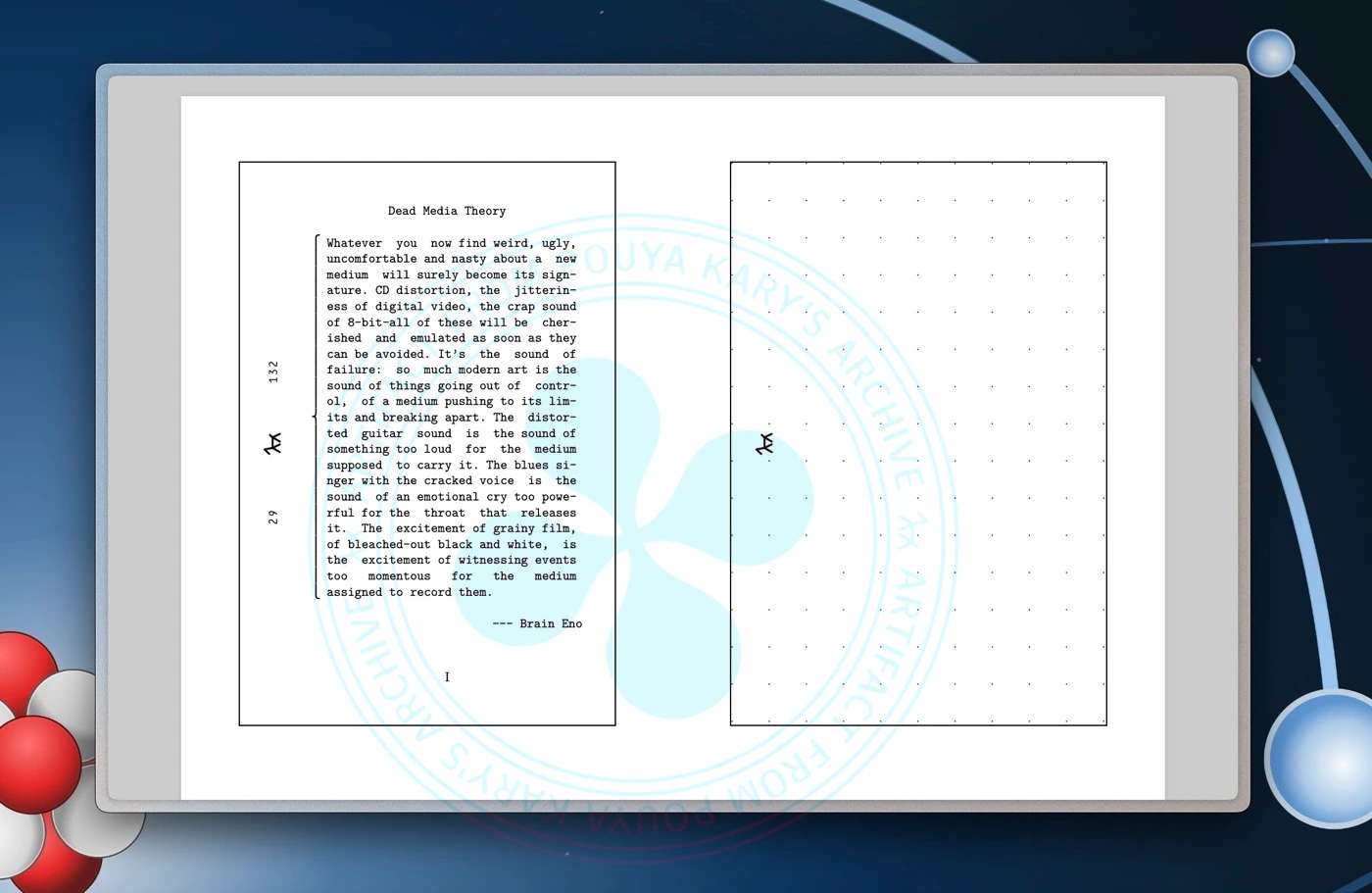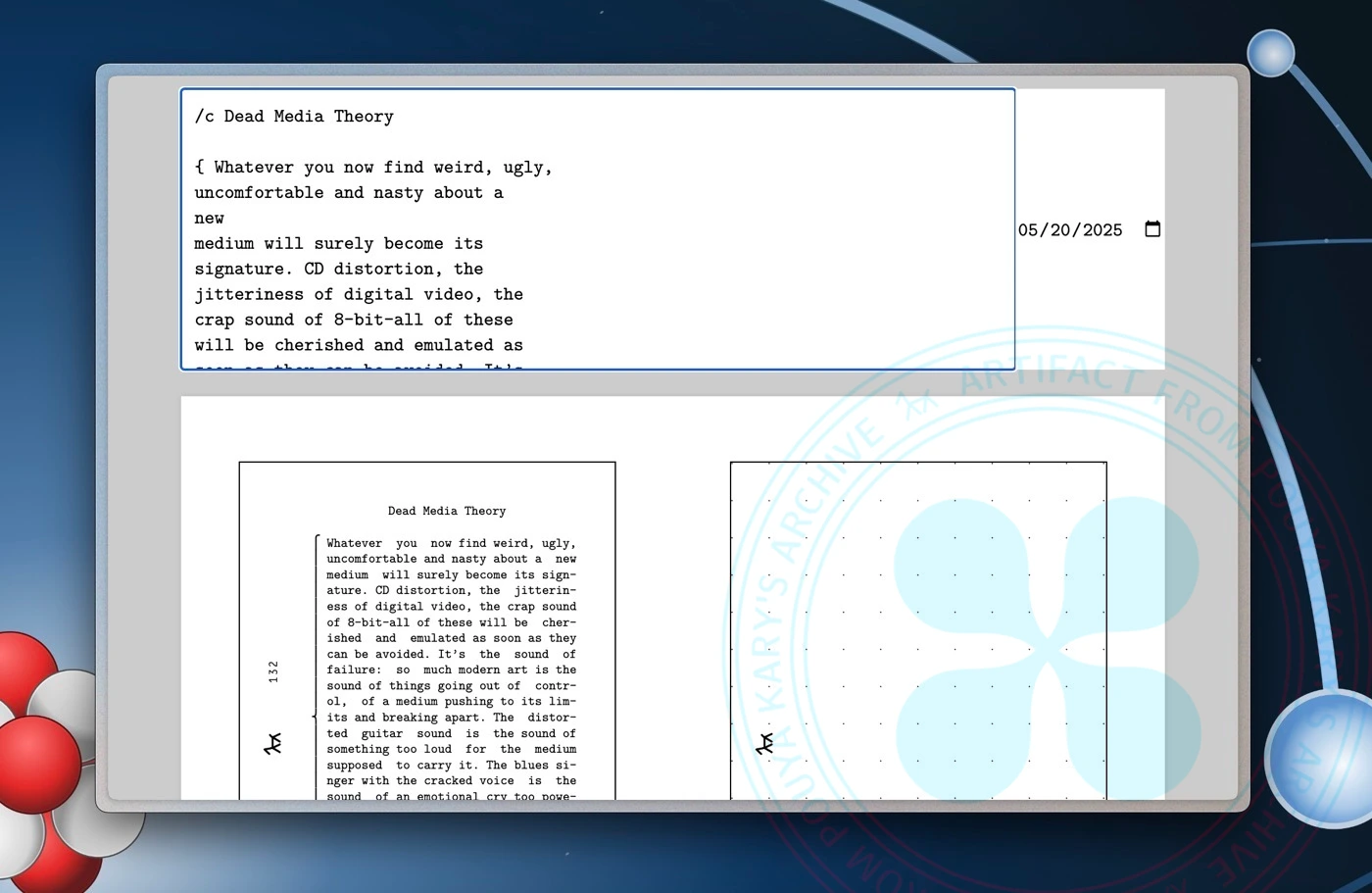Recently, I read a great quote by Brian Eno, which encapsulates much of what I have to say about Archive:
Whatever you now find weird, ugly, uncomfortable and nasty about a new medium will surely become its signature. CD distortion, the jitteriness of digital video, the crap sound of 8-bit-all of these will be cherished and emulated as soon as they can be avoided. It’s the sound of failure: so much modern art is the sound of things going out of control, of a medium pushing to its limits and breaking apart. The distorted guitar sound is the sound of something too loud for the medium supposed to carry it. The blues singer with the cracked voice is the sound of an emotional cry too powerful for the throat that releases it. The excitement of grainy film, of bleached-out black and white, is the excitement of witnessing events too momentous for the medium assigned to record them. <author>Brian Eno</author>
I have put so much time into visually designing the Archive, and also technically developing a resilient foundation that I can trust to work for years to come, under the huge pressure of all my daily usage.
In designing the Archive, I have spent years thinking about how to design a meta-medium that works to capture my life (which I hoped would be a long and huge experiment). I had many thoughts in mind:
- Capturing all sorts of different things: Memories, Photographs, Thoughts, Documents, Progress of Projects, Progress of Reading Books, the Quotes I read that day, …
- Capturing the relationship between these things: What book was the source of what quote? What sources influenced a work I had? What was the timeline of my projects?
- Capturing the timeline of my progress: What portion of something I worked on today, what tomorrow, what else…
In doing so, I realized there are far too many things to have in this medium, so I narrowed it down to four: Text, Photographs, Logs, and Quotes. That was already a tough compromise, but I had no choice but to go with it until I had created a medium to capture all sorts of intellectual materials. And then, in doing so, I went for this maximalist and highly detailed design. Unlike most modern software, the Archive is not something that hides so the content looks its best; it is, if anything, as much the content itself.
And I think this is where Brian Eno’s quote strikes. The Archive is meant to be a piece of art. I went miles ahead of myself to do all these little things to make sure nothing about it feels familiar. I wanted something new in every way, that still was completely me, as this Archive is somewhat the whole of my work. And somewhere along the way, I realized how well the design complements the idea of the Archive: that the medium is not enough for what it is trying to capture.
At the beginning of the Society of Spectacle, Guy Debord writes:
The images detached from every aspect of life fuse in a common stream in which the unity of this life can no longer be reestablished. Reality considered partially unfolds, in its own general unity, as a pseudo-world apart, an object of mere contemplation.
The thing about Archive is that, if I go one step ahead, it becomes a mess of intermingled databases of things and their overcomplicated relationships. Even more complicated being the practices to combine them.
And this again leaves me with the thought of that meta medium I’m so craving for.

This is a word processor for the Pocket Sheet of the Filofax. Has its own markup language with tiny commands, formats the given data and creates a double sided print template by cutting and arranging pages. I didn't thought I reach this far, but here we are, I made my long lasting wish from the TextGraphic coming to life.

And this is the tiny look at its tiny language.
Gabriel Lame lived and worked in France. He enjoyed inventing new shapes and describing them with formulas. [...] one such shape he devised became very famous: The Superellipse.
Engineer mathematician Piet Hang later used the superellipse to design a large traffic plaza in Stockholm it turned out both beautiful and convenient for cars not quite round and not quite rectangular.